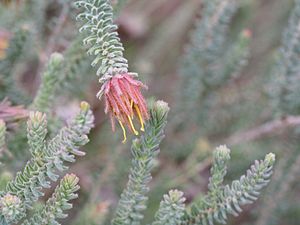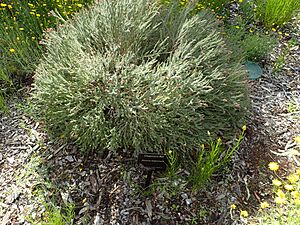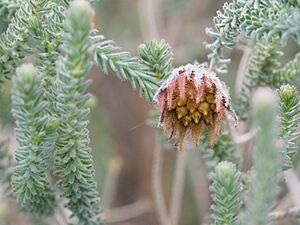Chapman's bell facts for kids
Quick facts for kids Chapman's bell |
|
|---|---|
 |
|
| D. chapmaniana leaves and inflorescence | |
| Conservation status | |
| Scientific classification | |
| Genus: |
Darwinia
|
| Species: |
carnea
|
 |
|
| Occurrence data from AVH | |
Darwinia chapmaniana, also known as Chapman's bell or Eganu bell, is a special plant from the myrtle family. It grows only in the south-west part of Western Australia. This plant is a low, rounded shrub that spreads out. It has greyish, hairy leaves and its flowers grow in groups of about 14 small, tube-shaped flowers. These flower groups are surrounded by long, reddish-yellow, hairy leaf-like parts called bracts.
Contents
What Does Chapman's Bell Look Like?
Darwinia chapmaniana is a rounded, bushy shrub. It usually grows to about 0.3 metres (1 ft) tall and can spread up to 3 metres (10 ft) wide. Its leaves and flower clusters have a unique smell, a bit like curry!
The leaves are crowded together near the ends of the branches. They are greyish-green, long and thin, and shaped like a triangle if you cut them. They are also covered with short hairs.
The Flowers
The flowers of Chapman's bell grow in groups of 12 to 16 flowers. Each group is about 9–15 centimetres (4–6 in) across and grows at the end of a branch. These flower groups are surrounded by layers of special leaves called bracts. The longest bracts are reddish-yellow and about 4–7 millimetres (0.2–0.3 in) long, with long, reddish-yellow hairs along their edges.
Each individual flower is yellowish and shaped like a tube, about 3–4 millimetres (0.1–0.2 in) long. Inside the flower, the parts that make pollen (called stamens) and other small parts (called staminodes) are hidden by the petals. The long, curved part of the flower (called the style) is about 8–10 millimetres (0.3–0.4 in) long and sticks out beyond the petals and bracts. It's yellowish-red and has a band of hairs near its tip.
Chapman's bell usually flowers between September and November, but mostly in October. After flowering, it produces a small, dry fruit that holds one or two seeds.

How Was It Named?
The first official description of D. chapmaniana was written by Greg Keighery in 2009. He published his findings in a science journal called Nuytsia. He found the first example plant (called the type specimen) near a town called Coorow. The second part of the plant's name, chapmaniana, was chosen to honor Charles Chapman. He was a farmer who collected the very first samples of this plant.
Where Does It Grow?
This special plant is only found in a small area near Coorow in Western Australia. It likes to grow around salt lakes, in areas with woodlands (forests) or shrublands (areas with many shrubs).
Is It Protected?
Yes, Darwinia chapmaniana is considered a very important and rare plant. The Western Australian Government's Department of Parks and Wildlife lists it as "Threatened Flora." This means it's a rare plant that needs protection.
It's also listed as "Endangered" (EN) under a big Australian law called the Environment Protection and Biodiversity Conservation Act 1999 (EPBC Act). This means it's at high risk of disappearing forever.
Some of the things that threaten this plant include:
- Land clearing: When land is cleared for farming or building.
- Soil salination: When the soil becomes too salty.
- Weed invasion: When other plants (weeds) take over its habitat.
- Grazing: When animals eat the plants.



